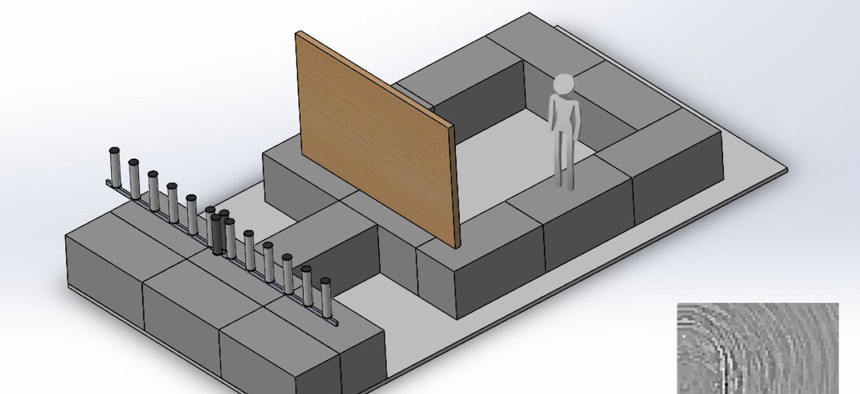
Illustration of the lab setup for m-Widar, with transmitters and receiver at left and person behind wallboard at right. Inset at lower right shows the corresponding image produced by the instrument NIST
New Radar Method Could Reveal Space Junk, Super Fast Missiles, Objects Behind Walls
Multiple transmitters processed through a new algorithm can spot very difficult-to-track targets.
A new take on radar could enable the military to better monitor space junk and track hypersonic missiles. It might also help soldiers to see enemies through urban walls or first responders locate people in collapsed buildings.
Conventional radar uses a transmitter to send a signal that bounces off of an object and then is picked up by one or more receivers. The time it takes the signal to hit the receiver reveals the distance between the object and the transmitter, thus, roughly, where it is and how fast it’s moving.
The new method, dubbed m-Widar, uses multiple transmitters and a single receiver. This setup allows much faster scanning and returns much more data, which is processed to produce an image within microseconds, far faster than conventional radars.
The method was developed at the National Institute of Standards and Technology, or NIST, by Fabio da Silva, who is now the CEO of Wavesens, a company he founded after patenting the method. Da Silva said he was inspired by single-pixel cameras.
“The choice of a single receiver and multiple transmitters was inspired by research done originally in optical systems using a technique called compressed sensing. In it, researchers proposed the concept of a single-pixel camera that used multiple transmitters (actually projector pixels) and a single detector. I translated those ideas to the radiofrequency regime and came up with a radar equivalent.”
They tested the system, dubbed m-Widar, through simulations and in a laboratory setting and found that they were able to track objects, such as a person, behind a wallboard, which could be useful in helping operators operating in chaotic urban environments. They demonstrated “through-wall real-time imaging, tracking, and observe second-order images from specular reflections,” as they put it in their paper published on Friday in the journal Nature Communications.
“The through-the-wall penetration is due to the fact that microwaves penetrate most optically opaque objects such as concrete, wood, etc. The exceptions, obviously, are metal or very lossy materials such as seawater where the penetration is very short,” da Silva said.
The model needs only a few microseconds of data to construct an image, which could be very useful in tracking objects that move at speeds that defy conventional radar methods. Da Silva explained that that is because the transmitters are able to scan the entire area at once. Traditional radar techniques use beam scans as well as frequency scans which naturally increase capture time for the same scene.”
He says that some very good radars get frame rates of 30 Hz, whereas his frame rate is 366 kHz.
“If we include our image-reconstruction algorithm, that number becomes more like 700 Hz, which is still 35 times higher than what has been published in the literature,” he said.
That could be very useful in tracking space debris moving at more than 20,000 miles per hour or even hypersonic weapons traveling at five times the speed of sound.
“Moving platforms traveling at speeds of 1-10 km/s and possibly covered in a plasma envelope put a lot of demands on radar systems and require adaptive responses at times of the order of a few seconds,” da Silva said in an email. “The m-Widar may be useful in such scenarios because it scans the entire volume of interest in all directions simultaneously in a few milliseconds (accounting for the propagation round trip of 1 to 100 nautical miles).”
Da Silva said he is also investigating if the algorithm could be used in applications where it’s important the enemy not know that radar is being used. “The key is that the m-Widar signal is not correlated at different space-time points and thus that can be an advantage against electronic countermeasure systems,” said da Silva. “Lastly, our reconstruction algorithm can produce images at a rate of hundreds of frames per second and can be the input of machine learning (ML) algorithms such as convolutional neural networks to produce fast and reliable tracking information.”




